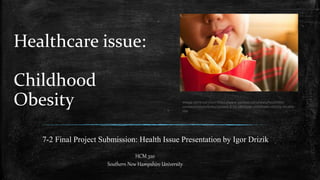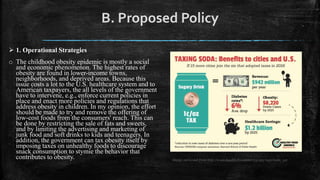The document addresses childhood obesity as a significant health concern in the U.S., highlighting its rising prevalence among children and the economic factors contributing to this trend. It details how obesity is linked to socioeconomic factors, health care costs, and the accessibility of unhealthy food options, while also discussing the roles of government agencies and proposed policies to mitigate the issue. The necessity for community involvement and comprehensive public health strategies is emphasized to eradicate childhood obesity and improve children's health.








![B. Proposed Policy (continued)
2. Healthcare organizations
o The Centers for Disease Control and Prevention
(CDC), the nation’s health protection agency,
already plays a major role in addressing the issue
of childhood obesity. “CDC works across the
health system to put the [the United States
Preventive Services Task Force] USPSTF
recommendation into practice, especially for
those children most in need.” (CDC, 2019). For
example, screening kids that are 6 years old and
older for obesity, and children who are already
struggling with obesity to be referred to high-
quality weight management programs. Also, the
CDC works across the healthcare system to
identify effective strategies that would improve
the situation. In fact, CDC targets both
improvements in physical activity and providing a
nutritious diet to reduce childhood obesity.](https://image.slidesharecdn.com/7-2hcm-320finalprojectigor11-190628041125/85/7-2-hcm-320-final-project-_igor_11-9-320.jpg)







